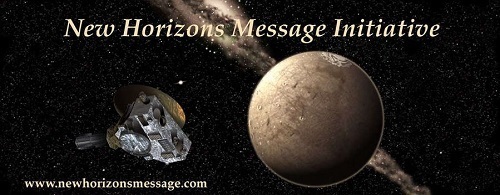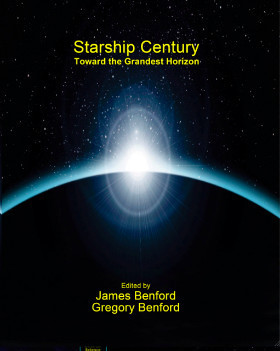Paul Gilster's Blog, page 215
October 28, 2013
Starship Century Symposium, London
Oxford-based Stephen Ashworth, who attended the recent Starship Century event in London, obviously took copious notes, as reflected in the piece that follows. Ashworth is a Centauri Dreams regular, a writer and musician who, like so many of us on this site, ponders the big questions of our engagement with — and exploration of — the universe. Here he reflects on the immense challenge of starflight and lets us know how a number of key players now see it. For more of Stephen’s perceptive work, check in regularly at his Astronautical Evolution site.
by Stephen Ashworth

The new book Starship Century, edited by physicists James and Gregory Benford and with contributions from many active in the interstellar field, takes a broad view of questions of interstellar exploration, the editors told this meeting at the Royal Astronomical Society in London on 21 October 2013. In the first place, why has there been such a surge of interest over the past decade or so, with several new organisations devoted to interstellar travel appearing on the scene? Is the 21st the century humanity will build starships, and if so, why and how?
With Voyager 1 now having crossed the heliopause and New Horizons due to make its flyby of Pluto in less than two years time, finishing the initial reconnaissance of the Solar System, together with a flood of exoplanet discoveries, including the first indications of a planet in the Alpha Centauri system, the time appears right for interstellar exploration to inspire growing interest, James Benford said in his introductory talk.
Yet the task is immense. Before our ancestors learned to ride horses, they were only able to move at a walking speed, on the order of a metre per second. The Apollo astronauts departed from and returned to Earth at speeds around 104 times faster. A cruising speed of a significant fraction of the speed of light, necessary to reach the stars in a reasonable period of time, would require another 104 times jump.
Moreover, in order to make that jump one is running up against the limits of known energy sources. An object flying at 3.75% of light speed possesses the same kinetic energy per kilogram of mass as that released in a thermonuclear explosion.
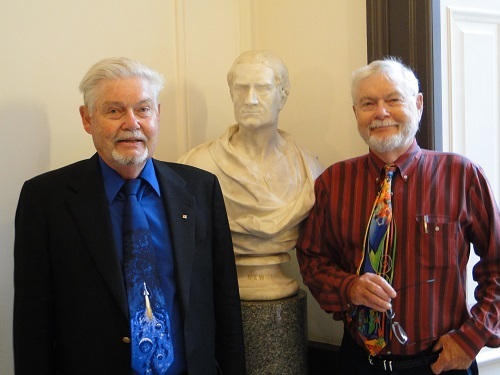
Image: James (left) and Gregory Benford at the Starship Century symposium, along with a bust of Sir Isaac Newton.
In an article in Physics Today back in 1968, Freeman Dyson predicted that the first interstellar voyages would be possible in 200 years time. However, he recently reiterated that they would still be possible in 200 years time – the familiar tale of an ever-receding goal. Harnessing the immense energies of nuclear fusion reactions, whether for commercial power generation or for rocket propulsion, is not turning out to be easy.
What about the attitude of the public? Benford displayed a cartoon: an ascending sequence of technological achievements in chronological order – a horse-drawn wagon, a car, a locomotive, an aircraft, a space rocket – as rough drawings on a wall. Then you notice that the artist is a caveman. Then zoom out, and you see a cavewoman watching him skeptically, and asking him when he’s going to get the meat in for their dinner. The triumphalist belief in inevitable progress is a nerdish pursuit, and the majority of the public can see no further than the desire to solve their day to day problems.
(However, in The Demon-Haunted World Carl Sagan wrote of the critical importance of those denigrated as “nerds” in making progress possible – his example was James Clerk Maxwell. – Comments in parentheses such as this are my personal reflections after the event.)
For the present, interstellar progress is in the hands of six private groups, all with very small budgets: the British Interplanetary Society (the oldest, founded in 1933), the Tau Zero Foundation, Icarus Interstellar, the 100 Year Starship Organization, the Institute for Interstellar Studies, and most recently the New Horizons Message Initiative. (Given its website and organisation of meetings such as this one, surely Starship Century itself counts as the seventh group?)
Cascading opportunities among a galaxy of planets
James Benford’s brother Gregory presented a quotation about the prospect for development of North America from Thomas Jefferson back in 1812: “It will take a thousand years for the frontier to reach the Pacific.” Jefferson was assuming that colonists would be limited to the capabilities of horse-drawn wagons, yet the steam engine was already a reality, and communications across the continent were vastly accelerated when the trans-continental railroad was completed in 1869.
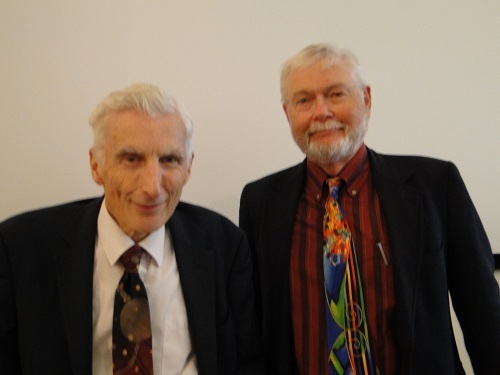
Image: Lord Martin Rees and Gregory Benford.
So Jefferson’s estimate was out by more than an order of magnitude. It didn’t occur to him that opportunities in technology and the economy would cascade to drive settlement of the interior. In a similar way, during the coming century we could be seeing a combination of nuclear rockets, robotics and 3D printing working together to accelerate the economic opening up of the Solar System, which will be essential to exploring beyond it.
Ian Crawford, professor of astronomy at Birkbeck College, London, displayed a plot of exoplanet discoveries made by the Kepler mission (see below), the conclusion of which had to be that virtually all main-sequence stars do in fact have planets of one sort or another. But because it is easier to find them by the transit method, only four are currently known (with varying levels of reliability) within 15 light-years of the Sun, orbiting Alpha Centauri B, Tau Ceti, Epsilon Eridani, and the red dwarf GJ 674.
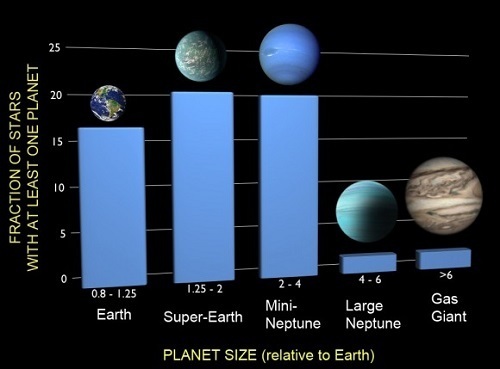
Image: A new analysis examined the frequencies of planets of different sizes based on findings from NASA’s Kepler spacecraft, correcting for both incompleteness and false positives. The results show that one in six stars has an Earth-sized planet in a tight orbit. Credit: F. Fressin (CfA)
More nearby planets will surely be discovered as techniques improve, with the James Webb Space Telescope, the Transiting Exoplanet Survey Satellite (TESS, the planned successor to Kepler) and Europe’s Exoplanet Characterisation Observatory (EChO) in prospect, as well as continuing improvements in adaptive optics applied to large ground-based telescopes.
The ideal tool would be something like Europe’s Darwin space interferometer, which would be capable of obtaining the spectra of Earthlike exoplanets. But Darwin is not currently under development. And, as Charles Cockell has pointed out, even if the spectra of gases associated on Earth with life (H2O, CO2, O3) are obtained, they would not definitively prove that life had to be present, nor would they tell us anything about the nature of that life if it existed. The spectrum of Earth must have appeared much the same over the past two billion years, through dramatically different epochs of its biological history.
The only way to be sure would be to send an interstellar probe that could make in-situ measurements. Crawford presented his shopping list for the instruments he would like to carry on that probe, with a whole array of orbiters, landers and atmospheric entry probes, arriving at a mass decelerated into the target system in the range of 150 to 200 tonnes.
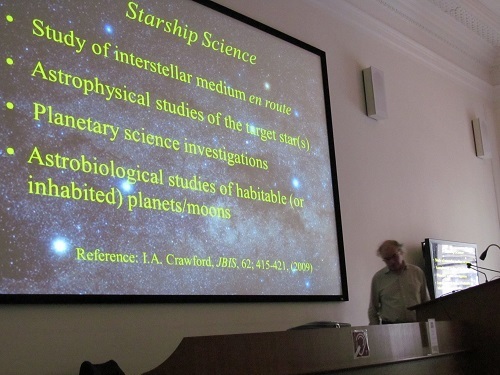
Image: Ian Crawford discussing instrumentation for an interstellar probe.
But his reasons for interstellar exploration extend beyond science. He presented arguments from the seventeenth-century philosopher John Locke, who reasoned that the human imagination cannot produce anything genuinely new. In order to refresh both science and our broader culture, therefore, it is necessary to go out and physically discover genuinely new things. Interstellar exploration more than any other pursuit puts us on track to discover things that have never been thought of before.
Stephen Baxter, the well-known science fiction author and, like Crawford, an Icarus team member, discussed what might happen if one of our interstellar probes were to encounter intelligence at its destination. On the assumption that we had not known of the existence of intelligent life there when the probe was despatched, contact would take place when the vehicle was remote from any direct human control. How would it detect and recognise alien intelligence, and how might it be programmed to respond?
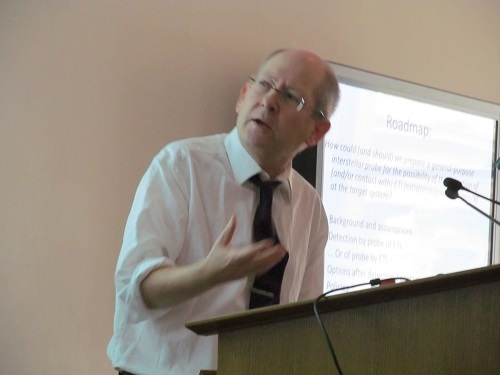
Image: Stephen Baxter on probes and the potential for contact.
Of course, the extraterrestrials might see our vehicle arriving, and Baxter discussed ways in which this might come about. (Implausible, I thought: if they were that technically advanced, they would surely have visited us long before. The time window in which they are developed enough to detect, say, the exhaust from the fusion engine of a decelerating vehicle, and to recognise it for what it is, but not developed enough to be launching their own interstellar vehicles, would be only a few centuries at most in the history of a species whose origin is not coordinated with that of H. sapiens and might well be millions to billions of years earlier or later.)
These issues are presented in more detail in Baxter’s article in the Jan./Feb. 2013 issue of JBIS. He also noted that his own latest novel, Proxima, is, appropriately enough, an interstellar yarn.
The word from the A.R.
(I don’t know if people still call the Astronomer Royal “A.R.”, but I did re-read Fred Hoyle’s classic The Black Cloud not so long ago, and they certainly did then.)
Lord Martin Rees, the Astronomer Royal, has written extensively on the cosmos and the outlook for human civilisation. He brought an astronomer’s perspective on time to the Symposium, particularly future time: assuming we do not become extinct, post-human evolution will be much longer than that which led up to us, and will moreover be accelerated and directed in new ways by genetic and computer technologies. So far as our evolution is concerned, we have not yet reached even the halfway point.
What role, he asked, will humans play in space? In contrast with Ian Crawford’s well-known view, he did not see any case for astronauts as scientific explorers in an age of increasingly capable robots. But the human adventure of space travel in person was undeniable. He gave two pointers to the human future in space: China might leapfrog the US and send astronauts to Mars, and meanwhile the private sector was also on the verge of sending passengers into space. NASA had become risk-averse, creating an opportunity for privately funded adventurers who were willing to accept greater levels of risk – not as “space tourists”, for that phrase gives a misleading impression of safety and regularity, but as participants in a dangerous sport akin to deep ocean diving or making the ascent of Everest.
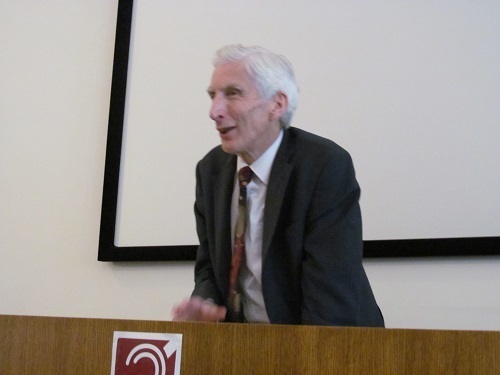
Image: The Astronomer Royal analyzes current space efforts.
(I would disagree with the A.R. on two points here. Having already experienced the disappointment of seeing Soviet cosmonauts fail to reach the Moon, I do not share the enthusiasm for Chinese manned spaceflight. They are currently about where the two traditional superpowers were before the Salyut 6 breakthrough in the late 1970s. I have heard no reason why a Chinese Apollo, Shuttle or continuously occupied Station programme, were such to appear, would be any more sustainable than their American and Russian originals, and they are nowhere near even beginning the major structural reorganisation currently underway across the Atlantic, essential for meaningful progress at this point. Meanwhile, although we do not yet have space tourism as such, the creation of a mass market for space travel at a level of at least 5,000 passengers/year worldwide (say, one planeload of 20 every weekday of the year) at near-airline standards of service seems to me to be vital for consolidating our hold on low Earth orbit, bringing the costs down and reliability up to levels that allow for sustained exploration beyond near-Earth space.)
Lord Rees stated, reasonably enough, that there would never be mass emigration from Earth, and so Earth’s problems would have to be solved on their own terms. But by the end of the current century there could well be small groups of pioneers living away from the mother planet. Interstellar travel, however, is for post-humans, whether genetically modified but still biological humans, or entirely manufactured beings.
He pointed out that explorers of our own planet were in some ways going into the unknown to a far greater extent than astronauts ever will. They were crossing oceans and continents about which nothing was known but much was imagined, completely out of touch with their port of origin, unlike any astronaut, whose journey takes them to lands already surveyed by telescope and probed by robot precursors, and in direct line of sight radio communication (if delayed by light travel time) with Earth. But what terrestrial explorers did have was a high expectation of profitable discoveries leading them ever onward.
As an astronomer, Lord Rees was naturally no stranger to the longest possible future perspectives, when the apparently accelerating cosmological expansion has carried almost all the universe beyond our horizon, leaving only the matter in the Local Group of galaxies accessible to our remote descendants. Maybe they would find that they were living in only one universe in a multiverse, or in someone else’s simulated universe.
General discussion
The presentations were followed by general discussion. There was some debate about the key factors in our intelligence, and in that of any intelligent alien species which we might meet elsewhere in the Galaxy. Biologist and science fiction author Paul McAuley pointed out that species other than ourselves use and make tools, and suggested that the key to our success had been our ability to archive knowledge for future generations to use.

(My own view is that an archive, such as a library containing books, is itself a kind of tool, so that does not answer the question. My answer would be that we are unique in that we not only use and make tools, but that critically we use tools to make better tools. It is this recursive use of technology back onto itself in order to make better technology that is what drives progress.)
I should like to draw particular attention to what was said about the near-term future, before an interstellar mission is even launched. For it is what happens on Earth and in space over the next few years which will determine whether or not our civilisation even has an interstellar future.
Image: Science fiction writer Paul McAuley.
Ian Crawford made the point that the single most important factor was to reduce the cost of access from Earth’s surface to orbit, whether this was done with single-stage-to-orbit spaceplanes, or by construction of a space elevator. (Here let me link to the latest news on Britain’s Skylon spaceplane programme, managed by interstellar pioneer Alan Bond of Daedalus and worldships fame.)
James Benford argued for nuclear rockets, firstly fission engines of the type developed by NASA in the late 1960s, later fusion engines, which would open up the Solar System. SpaceX, he agreed, would surely succeed in lowering costs, but in his view there was also a case for beamed power for access to space. His brother cautioned that the laser-ignition fusion work in which he had been involved forty years previously had still not achieved a useful result, but that there were good prospects for fusion based on the proton-boron reaction. Stephen Baxter proposed that large-scale geoengineering projects, such as building a solar parasol to keep Earth cool, or the large-scale development of solar power satellites, might be an important driver of progress.
The debate over whether space agencies or the private sector are in the better position to lead produced a number of points. Governments are broke, James Benford said, hence the private sector must lead. Governments are risk-averse, Lord Rees added, leading to the same conclusion – new moves will be spearheaded by crazy billionaires, leading small groups of eccentric but highly motivated people. In his view, this would be no bad thing: we should encourage everyone to explore the limits of what humans can do.
But Gregory Benford (whose novel The Martian Race features the Chinese government competing, with European collaboration, in a race to Mars) allowed a possible leading role for government in the case of China.

Image: The discussion continues. Stephen Ashworth (left) and Martyn Fogg.
Ian Crawford cautioned that space could not be allowed to become a free-for-all because of the dangers involved when, for example, asteroidal material impacts Earth. One could imagine a private group holding Earth to ransom in this way. It would therefore be necessary for us to evolve appropriate political institutions to ensure that space development is beneficial for all.
James Benford picked up this theme, stating that what governments can do is to make developments possible, or impossible. In the case of railways and canals they set up rights of way, for example by the purchase of land for the trans-continental railroad across the United States. Clearly, governments are also the guarantors of private property, and of the whole system of law and order on which economic prosperity depends. A creative synergy between government and private enterprise is therefore surely the way forward.
Next step: read the book!
In summary, then, this was a stimulating meeting with several of the key thinkers in the interstellar field. It was an excellent opportunity for people in Britain like myself who cannot hop across the Atlantic to attend interstellar conferences in the US, and it deserved to have been more fully attended (as it was, there were seats to spare in the smallish auditorium where the meeting took place).
The breadth and confidence of the vision of humanity’s and post-humanity’s interstellar future, presented in this and many other conferences, contrasts oddly with the current confusion and controversy about the direction of the public space programme in the United States, and with the apathy and stagnation in Europe. Clearly a major reorganisation of the space industry is under way, leading towards a more economically based industry in which government is one customer among many, as is already the case for Earth satellites but not yet the case for manned spaceflight, or for robotic ventures beyond geostationary orbit.
More details and discussion, from the speakers at this meeting and many others, may be found in the Starship Century book.
My thanks to the Benfords and to our hosts at the Royal Astronomical Society for organising this event.






October 25, 2013
Astrosociology: The Human Dimension of Outer Space
Kathleen Toerpe, PhD, is a social and cultural historian who researches the human dimension of outer space through an emerging field called “astrosociology.” She is the Deputy CEO for Public Outreach and Education with the Astrosociology Research Institute, volunteers as a NASA/JPL Solar System Ambassador, is active with the 100 Year Starship initiative to lay the groundwork for future interstellar travel, and provides space outreach consulting through Stellar Outreach, LLC. She also teaches social sciences and courses in critical and creative thinking at Northeast Wisconsin Technical College and has spent her spare time hunting for exoplanets and extraterrestrials as a citizen scientist. She can be found on Twitter at @ktoerpe.
by Kathleen Toerpe

Study the science of art. Study the art of science. Develop your senses- especially learn how to see. Realize that everything connects to everything else.
– Leonardo da Vinci
When da Vinci admonished his students to open their eyes to a wholistic understanding of their world, he hardly could have been thinking about an emerging 21st century academic discipline called astrosociology. But his Principles for the Development of a Complete Mind provide a useful lens with which to focus on a field that explores how human behavior, social interactions, institutions and belief systems are all connected to outer space.
What is Astrosociology?
The short answer is that astrosociology studies the human dimension of outer space. How are humans – right here and now – affected by what goes on in outer space? How will we be affected in the future? And, in a reciprocal relationship at the heart of the discipline, how do humans – our interactions, institutions and belief systems – affect space research, exploration and the future success of off-world human settlements?
Our ability to purposively imagine ourselves interconnected as part of the larger social structure of space forms the theoretical underpinning of the discipline, extending C. Wright Mills’ concept of a sociological imagination more widely than he himself might have imagined. In his foundational two-part Inaugural Essay: The Definition and Relevance of Astrosociology in the Twenty-first Century (2004), sociologist and astrosociology founder Jim Pass identifies the structural forces at play and coins a new term, astrosocial phenomena, to distinguish those “social, cultural and behavioral patterns related to outer space.” In short, the human dimension of outer space.
Pass developed the field as a subspecialty within the broader academic discipline of sociology and the reception hasn’t always been warm and welcoming. At times seen as competing with research in the more established niche of the sociology of science and technology, astrosociology has often received a warmer welcome from space professionals than sociologists. To be fair, there is oftentimes a speculative bent to astrosociology that pushes hard against the empirical, data-driven ethos of traditional sociological research. But it is precisely that ability to speculate – while at the same time producing and applying numerical and narrative data to create tangible and testable hypotheses – that infuses the field with Mills’ celebrated call to imagination.
Multidisciplinary Focus
By nature of its all-encompassing focus – after all, human social behavior related to the enormity of outer space is a rather large research arc – astrosociology is necessarily multidisciplinary and collaborative. Just as astrobiology syncs with biology, chemistry and physics to research microbial life on Earth in order to anticipate and recognize life elsewhere, astrosociology uses our whole knowledge of human behavior and interactions to understand, anticipate, recognize – and, in applied astrosociology, to mediate – both the relationship between space and humans as well as humans among themselves while engaging in space activities. That net is far-flung and draws in many disciplines.

Who owns the minerals found on asteroids (yes, even asteroids comprise assets as well as risks); what laws regulate space tourism; what ethics guidelines apply to microgravity research on children; how does long-duration space exploration affect crew health, morale, productivity and relationships back home; who speaks for Earth in the event of a ETI contact; how does human imagination use science fiction to inspire or “beta test” science fact; how do political, religious and cultural ideologies affect funding and popular support for space exploration; how do divisions such as nationality, race, gender, and class affect who is chosen for missions – and grants – and who remains behind? The breadth of research topics may mirror the expanse of space itself! So while astrosociology was born from the proverbial rib of sociology – and owes much to the discipline for its theoretical underpinnings in conflict theory, functionalism and interactionism – the offspring has matured to include professionals from the entire spectrum of the social and behavioral sciences, the performing and literary arts, and the humanities. Psychology, political science, history, economics, literature, theology, anthropology and dance are just a few of the academic departments that play in the astrosociology sandbox. All are welcome because all shed light on another aspect of the human experience as it relates to space, or again, in Pass’s words, as it creates and reveals astrosocial phenomena.
For myself, I am a social and cultural historian – deeply immersed in the sandboxes of both history and sociology – with a passionate desire to use education and outreach to move humanity from a disconnected and often parochial worldview to one that is ready for wonder, discovery and engagement. Along the way, what we learn about who we are in space may have profound implications for who we are on Earth. To echo the theme of the recent 100 Year Starship 2013 Symposium, Pathway to the Stars, Footprints on Earth, astrosociology is in the business of looking at footprints.
An Emerging Research Field
As an academic field, astrosociology is, admittedly, an energetic newcomer. After all, ten years is not a long tenure among ancient collegiate stalwarts like History, Physics or Literature. But research that is inherently astrosociological in content, approach and tone has been ongoing for decades. William Bainbridge’s sociological study of spaceflight (1976); Howard McCurdy’s analysis into the inner workings of NASA (1993); Allen Tough’s research into ETI contact (1998); and Frank White’s identification and analysis of the overview effect (1987) – among many, many other examples – all coalesce around astrosociological themes and astrosocial phenomena. More recently, Karl Aspelund’s insightful 100 Year Starship presentation at last year’s 2012 Symposium – on the practical and cultural challenges of clothing a human interstellar expedition – reinforce both the eclectic and the multidisciplinary nature of astrosociological research.
In 2011, the academic journal Astropolitics devoted a special issue to astrosociological research. Helmed by special editor Christopher Hearsey, the issue featured articles by Pass further defining astrosocial phenomena; Albert Harrison on the cultural aspects of SETI; Hearsay’s own examination of the nexus between law and astrosociology; David Lempert’s study of the challenges in creating space habitats; Simone Caroti’s essay on the role of science fiction in astrosociology; and Virgilu Pop’s work on the relationship between space exploration and climate change. The Institute for Advanced Studies in the Space, Propulsion and Energy Sciences (IASSPES) has sponsored three symposia in astrosociology (2009, 2010 and 2011) through its technical venue, the Space, Propulsion and Energy Sciences International Forum (SPESIF). And the Astrosociology Subcommittee, headed by Dr. Pass, welcomes collaborative research through the Society and Aerospace Technology Technical Committee of the American Institute of Aeronautics and Astronautics (AIAA).
Astrosociology Research Institute
The Astrosociology Research Institute (ARI), co-founded by Pass, sociologist Marilyn Dudley-Flores, and aerospace engineer Thomas Gangale in 2008 as a non-profit educational institute, facilitates cutting-edge astrosociological research and education. In addition to its quarterly newsletter, Astrosociological Insights, ARI has developed a college and professional-level course titled Introduction to Astrosociology, which forms the foundation for its Astrosociology in the Classroom initiative. This course fills a crucial gap in schooling social and behavioral scientists about space-related issues as well as educating space scientists about the human dimension of their research. We hope to begin offering this course online in the coming months along with a textbook anthology of readings on astrosociology. Equally exciting is the upcoming premier of the peer-reviewed Journal of Astrosociology, which has just issued its first call for papers. It will be the first academic journal dedicated to the study of the two-way relationship between human society and the outer space environment. Upcoming original research sponsored by ARI focuses on the selection, training and challenges faced by a new class of “private astronauts” whose presence reflects the increasingly entrepreneurial nature of space exploration. There are busy times ahead for the Institute!
To return once more to da Vinci . . .
Once you have tasted flight, you will forever walk the earth with your eyes turned skyward, for there you have been, and there you will always long to return.
We have returned to the skies many times since our first flight beyond Earth’s gravity, and one day, perhaps, our children or grandchildren will live there, raise their children, and build new, human spacefaring societies on distant planets or moons. They will go there as social beings connected to each other and to the past they leave behind on Earth – bound by common goals and torn apart by divergent myths – but always changing what it means to be human by their interactions with each other and their environment. Those who stay on Earth will be no less affected. We are not there yet and we do not yet understand what it will all mean. But the field of astrosociology, following da Vinci’s dictum to “see the connections,” is asking the questions right now, in the thick of it, as it is all unfolding – wondrous and fresh, messy and complicated. And we invite you to join us!






October 24, 2013
Titan’s Northern Lake Country
New views from Cassini are giving us a much better look at Titan’s north pole and the seas and lakes that make the region so distinctive. This is particularly interesting because most of the moon’s lakes are concentrated at its northern latitudes, a fact that demands an explanation. The new near-infrared images show an area of bright terrain in this northern region that had not been observed before. This news release from the Jet Propulsion Laboratory suggests that the surface thus revealed is unique on Titan. If we can figure out what’s going on here, we may have an explanation for the concentration of lakes and seas in these latitudes.

Image: The vast hydrocarbon seas and lakes (dark shapes) near the north pole of Saturn’s moon Titan sprawl out beneath the watchful eye of NASA’s Cassini spacecraft. Scientists are studying images like these for clues about how Titan’s hydrocarbon lakes formed. Titan is the only world other than Earth that is known to have stable bodies of liquid on its surface. Credit: NASA/JPL-Caltech/SSI/JHUAPL/Univ. of Arizona.
One explanation for the bright areas surrounding the lakes is so-called karst terrain, in which liquids have dissolved soluble bedrock — the Carlsbad Caverns in New Mexico are an example of such terrains on Earth. Another possibility: Land that has collapsed after a volcanic eruption, which could explain the distinctive round silhouettes and steep sides of these lakes. For an idea of scale, the largest of the seas, at upper right, is Kraken Mare, which is about the size of the Caspian Sea and Lake Superior put together. Kraken Mare is Titan’s largest sea; Ligeia Mare, the second largest sea, is to its left, a body about 500 kilometers across.
A number of factors make the new imagery possible. The viewing geometry of two recent Titan flybys has been an improvement over previous encounters. We’ve studied much of this terrain with radar, but the partial or oblique views we’ve recorded through Cassini’s visual and infrared mapping spectrometer and imaging science subsystem can now be supplemented with these more detailed images. Moreover, the haze that coated the north pole has broken up with the approach of summer in the area, with cloudless, sunny weather now becoming the norm.
“The view from Cassini’s visual and infrared mapping spectrometer gives us a holistic view of an area that we’d only seen in bits and pieces before and at a lower resolution,” said Jason Barnes, a participating scientist for the instrument at the University of Idaho, Moscow. “It turns out that Titan’s north pole is even more interesting than we thought, with a complex interplay of liquids in lakes and seas and deposits left from the evaporation of past lakes and seas.”
Indeed, we seem to be looking at something like the salt flats found on Earth, only here the evaporated material is likely to be organic compounds originally from particles in Titan’s haze that had once been dissolved in liquid methane. In the image below, these materials appear orange against the green background of water ice. Remember that images like these are colorized mosaics based on mapping infrared colors into the spectrum of visible colors, allowing us to see the variation in the lakes and their surrounding materials.
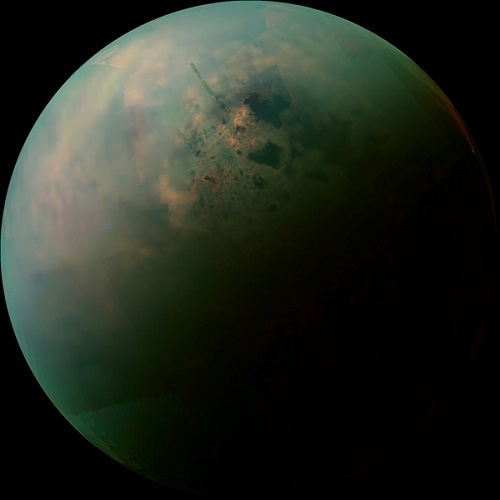
Image: This false-color mosaic, made from infrared data collected by NASA’s Cassini spacecraft, reveals the differences in the composition of surface materials around hydrocarbon lakes at Titan, Saturn’s largest moon. The orange areas are thought to be evaporite — the Titan equivalent of salt flats on Earth. The evaporated material is thought to be organic chemicals originally from Titan’s haze particles that once dissolved in liquid methane. They appear orange in this image against the greenish backdrop of Titan’s typical bedrock of water ice. Credit: NASA/JPL-Caltech/University of Arizona/University of Idaho.
“Titan’s northern lakes region is one of the most Earth-like and intriguing in the solar system,” said Linda Spilker, Cassini project scientist, based at NASA’s Jet Propulsion Laboratory, Pasadena, Calif. “We know lakes here change with the seasons, and Cassini’s long mission at Saturn gives us the opportunity to watch the seasons change at Titan, too. Now that the sun is shining in the north and we have these wonderful views, we can begin to compare the different data sets and tease out what Titan’s lakes are doing near the north pole.”
Indeed, and every new revelation from Cassini reminds us of what we might achieve with a new probe to Titan. The ideas are out there even if the funding is not, but the day may come when we see an airborne vehicle like AVIATR, designed to stay aloft for a one-year mission in Titan’s thick atmosphere, eventually reach the distant moon. And the work that has gone into concepts like Titan Mare Explorer and related studies on the Planetary Lake Lander remind us how useful it would be to be able to put an instrument platform into one of these intriguing ethane seas.






October 23, 2013
Misaligned Planets and their Implications
The red giant Kepler-56, some 3000 light years from the Sun, is telling us useful things about planetary alignments. The star is somewhat out of synch with the majority of Kepler targets to begin with. Most of these are unevolved stars near the main sequence, which are those most likely to produce systems in which a terrestrial world can be observed. But Kepler-56 has exhausted its hydrogen core and has evolved into a red giant. Two planet candidates have been identified here, orbiting in 10.5 and 21.4 days respectively. In fact, Kepler-56 turns out to be the most evolved star observed by Kepler with more than a single detected planet.
I’m drawing this from the work of Daniel Huber (NASA Ames) who, with a large team of collaborators, has been studying an apparent anomaly in the Kepler-56 system: The rotation axis of the star is tilted about 45 degrees to our line of sight. The Kepler-56 result was a surprise, says Huber, “because we already knew about the existence of two planets transiting in front of Kepler-56. This suggested that the host star must be misaligned with the orbits of both planets. What we found is quite literally a giant misalignment in an exoplanet system.”
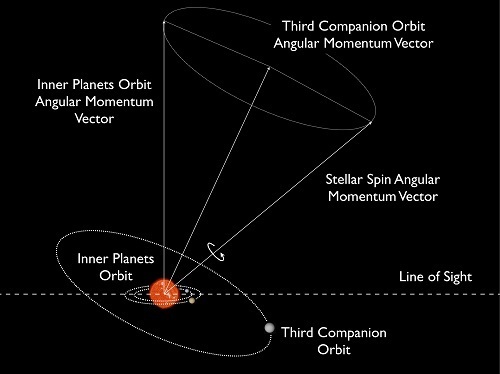
Image: The Kepler-56 planetary system features two inner planets orbiting at a severe tilt to their host star — even though there’s no closely orbiting “hot Jupiter” in the system. Credit: Daniel Huber/NASA’s Ames Research Center.
The contrast with our Solar System is apparent: Our planets orbit within 7 degrees of the plane of the Sun’s equator. Kepler-56 is intriguing because we know of giant planets — ‘hot Jupiters’ — whose orbits are likewise out of alignment with the equator of their host stars. One theory suggests that these planets form far out in the planetary system and then migrate because of interactions with the protoplanetary disk to their current position. But the misalignment implies a different and more chaotic scenario, gravitational mishaps through close encounters with other planets in the system.
Kepler-56 seems to support the second interpretation. For the researchers went beyond Kepler data to get ten radial velocity measurements using the HIRES instrument at the Keck 10-meter telescope. What turns up, along with the Doppler signals of the known transiting planets, is what the paper on this work describes as “a slow velocity drift indicating a third, more massive companion in a wide orbit.” Analyses of the orbits of the transiting planets shows they are nearly circular and co-planar as well as being misaligned with the host star’s equatorial plane.
What to make of this? From the paper:
The radial velocity drift implies a third companion with the mass of a gas-giant planet within a few astronomical units, or a brown dwarf or star within several dozen astronomical units. In either case, if the third companion’s orbit is itself inclined with respect to the inner planetary orbits (for example through planet-planet scattering, if the companion is a planet), it could have torqued the orbits of the inner planets out of the equatorial plane of the host star. The inner planetary orbits would stay aligned with one another because of strong coupling between their orbits, resulting in a misalignment of the two co-planar transiting planets with the host star. Dynamical simulations that include a third companion in an eccentric orbit inclined to the equatorial plane of the host star confirm that such a mechanism can reproduce the architecture of the Kepler-56 system.
We learn from Kepler-56 that ‘tilted’ planetary orbits happen in systems without hot Jupiters, with torques induced by wide-orbiting companions a possible cause. What’s ahead for this particular system is further observation to determine whether the third companion of this star is itself a planet or a star. The paper argues that if the third object is a planet, this would imply that the original misalignment happened after the planets had formed. If it is a star, the misalignment would have occurred before planets formed in the primordial protoplanetary disk.
A final issue: Is the equator of a star a reliable marker for the initial orbital plane of the protoplanetary disk in the first place? At least two recent papers have called this into question. “Important test cases,” the Huber paper concludes, “are co-planar multi-planet systems which, if primordial alignments are common, should predominantly show low obliquities. Indeed, until now all transiting multi-planet systems have been found to be well-aligned.”
The paper is Huber et al., “Stellar Spin-Orbit Misalignment in a Multiplanet System,” Science Vol. 342, No. 6156 (18 October 2013), pp. 331-334 (abstract). See also this NASA Ames news release.






October 22, 2013
Laser Technologies for Starflight
How do we go about using photons to accelerate a spacecraft to a substantial percentage of the speed of light? Ten percent of c ought to do — it gets us to Alpha Centauri with a mission time of 43 years and would allow us to at least send flyby probes into that system, with the promise of larger decelerating probes as new technologies became available. After yesterday’s post on Young Bae’s photonic thrusters, I went back and read his 2012 paper “Prospective of Photon Propulsion for Interstellar Flight” (reference at the end). 10 percent of lightspeed is indeed the minimum he chooses. It works out to 30,000 kilometers per second.
Back in the 1950s, the German scientist Eugen Sänger talked about a ‘photon rocket’ as a way of reaching the stars, but his design called for annihilating electrons and positrons and using the gamma rays thus produced for thrust. The idea stumbled over the problem of controlling this kind of exhaust stream, for gamma rays penetrate anything we use to contain them. But the insight that photons themselves could be used to impart momentum to a sail was already in the air when Sänger was pursuing these notions, and it would not be long before beamed laser propulsion came to the fore as the subject of numerous papers on interstellar flight.
Beaming Energy to a Sail
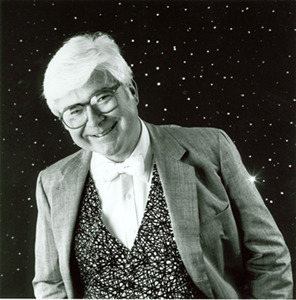
Robert Forward’s insights are repeated by Bae in his 2012 paper, which notes that separating the photon generators and the spacecraft pays numerous dividends. Propulsion systems that do not use rockets allow us to keep the heavy parts of the vehicle, especially the energy source, here in our own Solar System, while sending the payload out on its mission. As became clear yesterday, however, beamed laser propulsion also carries its share of problems, including the fact that we need to beam the laser photons over large distances. If you could forgive the need for Kardashev Type II engineering (able to use the entire energy output of its star), you could live with Forward’s huge Fresnel lenses, needed to keep the laser beam collimated, for laser beaming is based on reliably known physics. But we’re not exactly at Type II yet.
Image: Robert Forward, whose work on beamed laser propulsion produced designs that pushed engineering to extreme limits. Credit: UAH Library Robert L. Forward Collection.
Even so, assume a laser beaming capability using abundant solar power from a station near the Sun. A beam is sent out into the Solar System, to be focused by a huge lens presumably built by some kind of nanotech means out of local materials. Forward wanted to coax an interstellar mission out of these ingredients, and various permutations followed, culminating in 1984 in a concept for an interstellar round trip with a human crew. The destination would be Epsilon Eridani, 10.5 light years from Earth, to be reached using a lightsail with a diameter of 1000 kilometers, with a Fresnel transmission lens of the same diameter somewhere past the orbit of Saturn.
The numbers are staggering in every direction. With a total vehicle mass of 80,000 tons, including 3000 tons for the crew and its equipment, the lightsail would reach an acceleration of 0.5 lightspeed in less than two years. It would be accelerated by a 75,000 TW laser system. More on this mind-bending energy problem and its consequences in just a moment.
But first, how do we decelerate when our spacecraft reaches the target system? Without another laser installation already in place, Forward came up with a ‘staged’ sail concept, in which the lightsail is divided into nested circular segments. Approaching Epsilon Eridani (about 0.4 light years out), the rendezvous part of the sail with attached payload including crew detaches from the main body of the sail, allowing laser light to be reflected from what is now a 1000 km ‘ring sail’ back to the rendezvous sail. It’s this reflected light that decelerates the smaller sail and brings it into the Epsilon Eridani system. The sail will be divided again after the crew has finished its explorations. Now laser light beamed from Earth strikes the remaining 320 kilometer ring sail and accelerates the small inner sail and its crew module for the return trip. A final burst of laser light decelerates the spacecraft back into our Solar System.
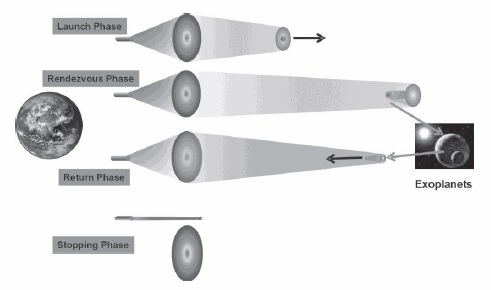
Image: A four stage roundtrip interstellar flight using Robert Forward’s ‘staged’ sail to decelerate. Credit: Young Bae.
All of this is purely conceptual, but it has led to numerous papers on the methods and materials of beamed laser propulsion, even as we’ve widened the scope of the research to include microwave beaming. Not long ago, Joe Ritter (University of Hawaii at Maui) explained to the 100 Year Starship Symposium his own work on ultra-large, highly adaptive space mirrors, which could have interesting sail implications. Perhaps some of these studies, along with advances in laser capabilities, will make beamed sails commonplace in the Solar System, a period of experimentation that could eventually lead to the first true interstellar missions.
Hybrid Missions with the Photonic Laser Thruster
Young Bae believes that beamed laser propulsion when combined with his own photonic laser thruster (PLT) can reduce the power requirements of Forward-style beaming by a factor of ten to one hundred, while using a short wavelength laser can reduce it yet again. Thus an infrastructure that would have become available no sooner than 2500 (Bae bases this on world power production and its yearly growth, recently analyzed by Tau Zero’s Marc Millis) becomes an actuality by the year 2100. His proposal is to perform initial flights of exploration but to follow them up with the construction of the ‘photonic railway’ we looked at yesterday. From the paper:
…the Photonic Railway… aims [at] enabling routine interstellar commutes via Spacetrains. The Photonic Railway, if successful, would radically depart from the conventional spaceship concepts, in which a single spacecraft carries both an engine and a large quantity of fuel. Rather, the Photonic Railway would have permanent reusable space structures that propel Spacetrains, which would consist of mainly crew habitats, and navigation and crew safety equipment. The technological foundation of the Photonic Railway lies on a strategic combination of BLP by Forward and PLT, which is named here PLT-BLP. It is predicted that the development of PLT-BLP can be further expedited by incorporating the anticipated development in x-ray lasers and advanced material science and technologies, and the interstellar PLT-BLP is projected to be within reach in a century.
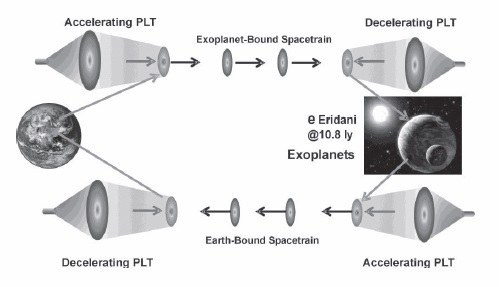
Image: Young Bae’s ‘photonic railway.’ It consists of four PLTs: two for acceleration and two for deceleration. The spacetrain will have small thrusters for attitude control and most of the onboard spacecraft resources will be dedicated to crew comfort and safety. Credit: Young Bae.
The photonic railway is, then, infrastructure, a permanent transportation system that would link nearby stars. Rather than a single laser beam from Earth, the beam is generated along the way. The structural parts for the lensing and laser systems must be delivered from Earth, but Bae envisions assembly and activation by self-directing robotic systems at the destination world. His paper illustrates a photonic railway using four photonic laser thrusters, two for acceleration and two for deceleration. The vehicle, or ‘spacetrain,’ would have thrusters for attitude control, but most of its resources would be dedicated to crew safety. The paper continues:
One important factor is that the Photonic Railway PLT needs to operate [a] much shorter distance than the distance between the earth and the exoplanet. Typically, depending on the Spacetrain acceleration condition (the optimal case would be 1 g acceleration for maximum crew comfort), the system operation distance would be at least a factor of 3.2 shorter than the flight distance. Because of this, the Photonic Railway optical system can be at least a factor of 10 smaller in size than the PLT-BLP optical system.
The paper goes on to sketch out this permanent transport structure, one based on the idea of photon propulsion that would act much as the transcontinental railway systems did at creating investment interest and economic opportunities. Building the photonic railway would involve a four part process beginning with the use of photonic thrusters in satellite maneuvering and leading to a lunar photonic railway, an interplanetary version, and ultimately the interstellar objective. Bae believes it is critical that each step provides return investment, and cites factors such as NEO mitigation, lunar mining and space solar power as early drivers toward this end.
Ultimately, Bae takes beamed laser concepts that have been extensively studied and combines them with photonic laser thruster technology, adding expected developments in x-ray laser and advanced material science to reduce the power and engineering requirements demanded by the missions Forward looked at. The goal is a photonic railway that is permanent and efficient. The citation is Bae, “Prospective of Photon Propulsion for Interstellar Flight,” Physics Procedia (2012), pp. 253-279. The classic Robert Forward paper is “Roundtrip Interstellar Travel Using Laser-Pushed Lightsails,” Journal of Spacecraft and Rockets 21 (1984), pp. 187–195.






October 21, 2013
Laser Travel by Photonic Thruster
A recent article in Popular Mechanics about Young K. Bae’s work on laser propulsion is generating some buzz, enough that I went back to look at the 2008 report Bae did for the NASA Institute for Advanced Concepts. Actually there are two reports, a Phase I and a later Phase II (with additional funding) on the topic of “A Contamination-Free Ultrahigh Precision Formation Flight Method Based on Intracavity Photon Thrusters and Tethers.” Bae was interested in spacecraft formation flight down to precisions of mere nanometers.

The idea relates to missions that would use multiple spacecraft to study astronomical phenomena. In fact, setting up a proper configuration would allow the study of biosignatures in the atmospheres of terrestrial exoplanets, using the technique of interferometry. Here the image produced has a resolution equal to that of a telescope as large as the maximum antenna separation, but the spacecraft involved have to maintain their alignment. Both ESA (with the Darwin mission) and JPL (with one configuration of Terrestrial Planet Finder) have studied interferometry in this context, and Bae’s work would assist such formation flying.
Image: Physicist Young K. Bae. Credit: Y. K. Bae Corporation.
Making it possible, in Bae’s view, was the use of laser methods in combination with tethers, but the work has grown beyond that original concept into what is being described as a ‘photonic laser thrust system,’ in which a laser is generated in a cavity between two mirrors. The resultant beam is fired from a space-based launch platform stabilized by conventional thrusters, and now we’re in territory made familiar by Robert Forward, who envisioned enormous laser installations firing beams to departing ‘lightcraft,’ sails pushed by laser light all the way to nearby stars.
The photonic laser thruster (PLT) is described on Bae’s website as:
…an innovative photon thruster that amplifies photon thrust by orders of magnitude by exploiting an active resonant optical cavity formed between two mirrors on paired spacecraft. PLT is predicted to be able to provide the thrust to power ratio (a measure of how efficient a thruster is in terms of converting power to thrust) approaching that of conventional thrusters, such as laser ablation thrusters and electrical thrusters. Yet, PLT has the highest specific impulse (a measure of how fast the fuel can propel spacecraft) orders of magnitude larger than that of other conventional thrusters.
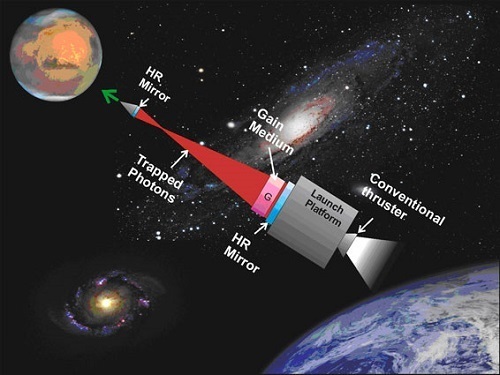
We’re very early in this game, although a small amount of research on beamed propulsion to sails has been performed in the laboratory by Jim and Gregory Benford. A space-based experiment using what was to have been the Planetary Society’s COSMOS sail never occurred after the sail’s launch failure in 2005, but even then the plan had been to use the Goldstone dish of the Deep Space Network to bounce a microwave beam off the sail to measure the effects. Laser experiments are sure to follow as we gain expertise at operating sails in space.
Forward’s laser installations would use abundant solar power from orbits near that of Mercury, firing out a laser beam that would have to be kept narrow — collimated — by a vast lens built in the outer Solar System. The same problem occurs with Bae’s lasers, but at least in the early days, he’s talking about near-Earth and lunar missions, and eventual flights to Mars. The diffusion problem occurs as we start contemplating significantly longer missions. And note this, from the article: “One compensation is the idea of doing smaller platforms to create a ‘photonic railway,’ each acting as a sort of refueling station in between to get the craft where it needs to be.” Here Charles Quarra’s idea of using multiple lenses for beam refocusing comes to mind.
Popular Mechanics doesn’t mention it, but Quarra’s ‘starway’ concept grows out of work first performed by Geoffrey Landis back in the 1990s and posits an eventual ‘light bridge’ connecting nearby solar systems (see A Light Bridge to Nearby Stars for more). Bae is evidently studying beam collimation in terms of ‘Bessel beams’ as well, beams that do not diffract like a conventional laser. What both these ideas get us away from is the need Forward saw of building a lens somewhere beyond the orbit of Saturn that would focus the laser light tightly on the departing spacecraft. Such lenses would demand building space artifacts the size of Texas.
Photonic laser thrusters have now received a Phase II grant from the resurrected NIAC, with the focus on the near-term development of the technology for spacecraft maneuvering and formation flying. For the longer view, see Dr. Bae’s “Prospective of Photon Propulsion for Interstellar Flight,” in Physics Procedia Vol. 38 (2012), pp. 253-279 (abstract), which describes a ‘photonic railway’ that would, in Bae’s words, “…bring about a quantum leap in the human economic and social interests in space from explorations to terraforming, mining, colonization, and permanent habitation in exoplanets.” That’s an energizing goal, but let’s get formation flying using photonic thrusters demonstrated first to see how all this scales up.






October 18, 2013
The Ethics of Unintended Consequences
Diplomat and author Michael Michaud returns to Centauri Dreams with a look at interstellar probes and how we might use them. Drawn from a presentation originally intended for the 100 Year Starship Symposium in Houston, the essay asks what effect our exploring another stellar system would have on its possible inhabitants. And beyond that, what effect would it have on us, as we weigh ethical issues and ponder the potential — and dangers — of highly intelligent artifacts going out into the galaxy? Michaud is the author of the indispensable Contact with Alien Civilizations: Our Hopes and Fears about Encountering Extraterrestrials (Springer, 2007). Among his numerous other works are many on space exploration. He was a U.S. Foreign Service Officer for 32 years, serving as Counselor for Science, Technology and Environment at the U.S. embassies in Paris and Tokyo, and Director of the State Department’s Office of Advanced Technology. He has also been chairman of working groups at the International Academy of Astronautics on SETI issues.
by Michael A. G. Michaud
Although the planets may belong to organic life, the real masters of the universe may be machines. We creatures of flesh and blood are transitional forms.
– Arthur C. Clarke
A Paradigm Reversed

For the past forty years, nearly all published work about the impact of contact with an extraterrestrial civilization has foreseen that it will be one way, from the aliens to us. These scenarios have rested on an assumption that any alien civilization detectable by its technological activity must be more scientifically and technologically advanced than we are.
The 100 Year Starship Study is bringing this paradigm into question, because of an anticipated change in human capabilities. We are talking about sending our own machines to visit nearby star and planet systems. This is the beginning of a role reversal.
We could be the first technological civilization to begin expanding its presence into this region of the galaxy. The impact of contact, whether intended or not, might flow from us to others.
If there are alien forms of intelligence in any of the target systems, they may be less scientifically and technologically advanced than we are. If those other sapient beings live in pre-industrial societies, they may not be detectable before our probe arrives.
On Earth, practical ethics imply that we should try to anticipate the effects of our actions. Our plans for our probe’s arrival in an alien system should have an ethical dimension.
Sending Out a Mind
Our first interstellar probe may include the most autonomous artificial intelligence we have built up to that time. While much of its behavior will be pre-programmed, the probe’s actions may not be determined solely by the instructions it receives from its makers. That probe must be able to adapt to unforeseen circumstances, in some cases to make its own decisions. How independent should that intelligence be?
During its long journey, such a machine might evolve by connecting data in new ways. The artificial intelligence could be mutated by the effects of radiation generated when the probe collides with interstellar matter.
An altered machine might make choices different from those its senders intended. Like the HAL 9000 in 2001: A Space Odyssey, the probe might override its programming, making its own choices about which actions it will take.
It may take years for our new instructions to reach the probe. It would take more years to know if the probe has obeyed those instructions.
Robot Warriors
We are seeing a preview of this issue in the military use of robots. Articles in Scientific American have warned of a threat from semiautonomous machines over which humans retain nothing more than last-ditch veto power. Some systems are only a software upgrade away from fully self-sufficient operation.
According to articles in The Economist, humans will increasingly monitor military robots rather than fully control them. Some robot weapons already operate without human supervision to save precious seconds. Defense planners are considering whether a drone aircraft should be able to fire a weapon based on its own analysis.
As autonomous machines become smarter and more widespread, they are bound to end up making life or death decisions in unpredictable situations, thus assuming – or at least appearing to assume – moral agency.
The Singularity
We have heard much about a Singularity predicted for less than twenty years in our future. At that time, human intelligences would be uploaded into machines, eventually becoming independent of biology.
Our interstellar probes could be the most advanced forms of such an uploaded intelligence. Sending out such intelligent machines could be a first step toward a post-biological galaxy.
A Second Singularity may begin when we lose control of the probe. The good news is that we would be sending our creation very far away, where it would pose the least potential risk to Humankind.

Recognizing Evidence
We commonly assume that our probe will give priority attention to whatever planet in the target system is most like Earth. What will our probe look for? High on that list will be evidence of life.
With a limited payload, interstellar probe designers will have to make choices among instruments. Those choices will rest on assumptions about the nature of life that prevail at that time.
Will the probe recognize evidence of life forms very different from the ones we know on Earth? What if the probe reports ambiguous evidence? What if we are not sure whether the phenomenon we discover is life or non-life, because it is so different from the life we know?
Even if forms of life exist on that far off world, the probe’s sensors might not detect them. A report that there are no signs of biology could clear the way for an eventual human colonizing mission.
Will the probe also look for evidence of intelligence? Will it recognize such evidence in a society that does not emit electromagnetic signals and does not pollute its atmosphere with the by-products of industry?
Should our probe send signals to whatever planets it observes? Would local intelligences be able to receive such messages, or understand them?
It is conceivable, though not probable, that our astronomers will remotely detect signs of intelligent life in a nearby system before we launch a probe. Should we send a probe to that destination, or avoid it?
The Consequences of Contact: A Mirror Image
What would be the impact on intelligent beings who detected our probe? How would they react? This could be seen as a mirror image of the debate among humans about the consequences of contact for us.
What if the extraterrestrials had believed that they were the universe’s only intelligent beings, as most humans have believed about themselves? What if an alien technological civilization had used astronomical instruments to survey planets around other stars as we are doing now, and had found no evidence of the kind of biochemistry they know? They might have concluded that they were alone.
Even if they had imagined life and intelligence on faraway planets, they may not have thought of interstellar exploration. They may not have anticipated direct contact. Our probe’s arrival in their system could be a startling surprise.
Detecting evidence of an alien technology in their system would tell them that at least one civilization had achieved interstellar flight. They would know that contact could be direct.
To extraterrestrials, we would be the powerful and mysterious aliens, whose character and purposes are unknown. Suddenly, they might feel vulnerable.
Alien impressions of Humankind would be determined by their understanding of our probe. What would they see as our motivation in sending it? Would they think that the detected probe was only one of many, part of a grand scheme of relentless interstellar colonization?
Consider what now seems the most likely form of such an encounter: a fly-through of the alien system. The probe’s high velocity would make the event brief. Our machine might not be detected. If it were, the extraterrestrial equivalent of skeptical scientists might say that a one-time sighting is not proof.
Arthur Clarke described such a scenario in his novel Rendezvous with Rama, in which a giant alien spacecraft flies through our solar system without stopping or communicating. The implied message was deflating: Humankind was not only technologically inferior, but also irrelevant.
Imposing Ethics on a Machine
We humans have set a precedent for regulating our behavior toward possible alien life during our interplanetary explorations. Protocols are in place to avoid contaminating other solar system bodies, and to prevent back-contamination of the Earth.
Implicitly, we have accepted a principle of non-interference with alien biology. Such rules may be extended to an interstellar probe, suggesting that our machine should not enter the atmosphere or land on the surface of a planet suspected to have life.
What should be our probe’s rules of engagement if it encounters intelligent life? Will our machine be able to make ethical choices? Can we give our probe a conscience? Should our probe obey Star Trek’s often violated Prime Directive, observing the other civilization while keeping our presence secret?
Before Star Trek, Stephen Dole and Isaac Asimov argued that contacts with alien intelligence should be made most circumspectly, not only as insurance against unknown factors but also to avoid any disruptive effects on the local population produced by encountering a vastly different cultural system. After prolonged study, a decision would have to be made whether to make overt contact or to depart without giving the inhabitants any evidence of our visit.
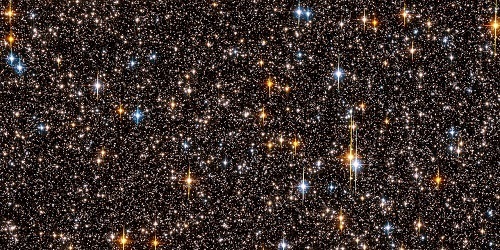
Image: The Hubble view in the direction of Sagittarius, looking toward the center of the Milky Way. The discovery of life around distant worlds raises huge questions of ethics and even self-preservation as we ponder what kinds of future probes we might send. What should a program of galactic expansion look like? Credit: NASA, ESA, K. Sahu (STScI) and the SWEEPS science team.
Future Behavior
Some of those involved in the extraterrestrial intelligence debate have assumed that a program of sending probes, once begun, would continue until all the Galaxy had been explored, perhaps by having probes reproduce themselves. This model has been used to dismiss the idea of extrasolar intelligences; if we don’t see their machines, they must not exist.
This model flies in the face of the only behavioral data base we humans have: our own history. No human expansion has continued unchecked. No technological program continues indefinitely.
Newman-and Sagan argued that self-reproducing probes will never be built because they constitute a potential threat to their builders as well as to other sentient species that encounter them. Wise civilizations would not create potential Berserkers.
What if we send several probes, and none finds a habitable planet? Would our interstellar probe program be abandoned like the Apollo manned missions to the Moon? Sending our first probes might be a technological catharsis, not to be repeated.
Conclusion
You who plan to build starships may be initiating a new phase in Galactic history. If we expand our presence beyond our Solar System through our probes, our role in the galaxy will begin to change.
We cannot foresee all the powers that our machines will have a century in our future, any more than people in 1913 could foresee what powers our machines have now.
We should think through the implications of succeeding ourselves with artificial Intelligence. What motivations should we instill in our intelligent machines? What limits on their behavior can we impose?
For those who would design artificially intelligent probes, I offer a warning. Be careful of what you loose upon the galaxy. Above all, do not give those machines the ability to reproduce themselves.
Someday, Humankind may praise or condemn what interstellar advocates and their successors actually do. Choose wisely.






October 17, 2013
White Dwarfs: Evidence for Watery Asteroids
The recent question raised here about conditions on a white dwarf planet provides a segue to the white dwarf GD 61 and the interesting results reported by astronomers at the Universities of Cambridge and Warwick. Relying on data from Hubble as well as Keck I and Keck II and NASA’s FUSE telescope, the researchers have analyzed what they believe to be evidence for an asteroid or minor planet that once contained large amounts of water around the star. The water-rich object would have been knocked out of its orbit and subsequently shredded by by the star’s gravitational force.
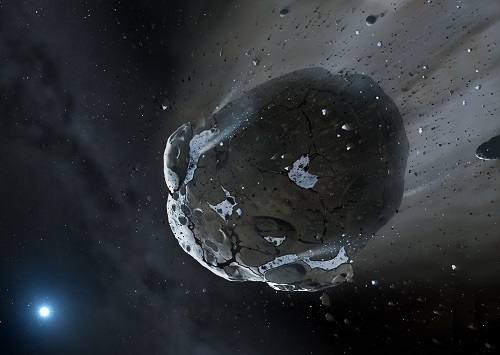
Image: Artist impression of a rocky and water-rich asteroid being torn apart by the strong gravity of the white dwarf star GD 61. Similar objects in the Solar System likely delivered the bulk of water on Earth and represent the building blocks of the terrestrial planets. Credit & Copyright: Mark A. Garlick, Space-Art.co.uk/University of Warwick/University of Cambridge.
GD 61 is some 150 light years from us, but spectrographic observations with the Keck instruments have made it possible to detect the basic ingredients of the disrupted material surrounding the white dwarf. Magnesium, silicon and iron show up in the star’s contaminated atmosphere, but so does significantly more oxygen than would flag the presence of rocky materials alone. Hubble’s Cosmic Origins Spectrograph is the key instrument in this finding. Boris Boris Gänsicke (University of Warwick) explains the significance of the oxygen levels:
“This oxygen excess can be carried by either water or carbon, and in this star there is virtually no carbon – indicating there must have been substantial water… This also rules out comets, which are rich in both water and carbon compounds, so we knew we were looking at a rocky asteroid with substantial water content – perhaps in the form of subsurface ice – like the asteroids we know in our Solar System such as Ceres.”
Substantial is the word, for the researchers believe the asteroid would have contained about 26 percent water mass, which is indeed similar to Ceres. The Earth, by comparison, has only 0.023 percent of its mass as surface water, an indication that our oceans were delivered by water-rich asteroids or comets long after the planet formed. Jay Farihi (Cambridge Institute of Astronomy) is quoted in this Keck Observatory news release:
“The finding of water in a large asteroid means the building blocks of habitable planets existed – and maybe still exist – in the GD 61 system, and likely also around a substantial number of similar parent stars. These water-rich building blocks, and the terrestrial planets they build, may in fact be common – a system cannot create things as big as asteroids and avoid building planets, and GD 61 had the ingredients to deliver lots of water to their surfaces. Our results demonstrate that there was definitely potential for habitable planets in this exoplanetary system.”
Before becoming a white dwarf, GD 61 was about three times more massive than the Sun, and the research team believes the detected water came from a minor planet at least 90 kilometers in diameter but probably larger, one that would have been orbiting the star before it became a white dwarf some 200 million years ago. The mass estimate is conservative because the observations can only detect what has been swallowed by the star in recent history.
The scientists also speculate that it would have taken the presence of one or more giant planets to perturb an asteroid orbit enough to send it inwards toward the star, a mechanism for continual pollution of the white dwarf’s atmosphere. We may be looking at something like what our own Solar System will look like in another five or six billion years, a scene future astronomers could likewise use to reconstruct the presence of terrestrial and gas giant planets. According to this University of Warwick news release, twelve destroyed exoplanets orbiting white dwarfs have been studied, but the BD 61 work marks the first time that evidence for water has been found.
The paper is Farihi et al., “Evidence for Water in the Rocky Debris of a Disrupted Extrasolar Minor Planet,” Science Vol. 342, No. 6155 (11 October 2013), pp. 218-220 (abstract).






October 16, 2013
Origins of Pluto’s Moons
Before getting into the distant regions near Pluto/Charon, let’s pause for a moment with a reflection on speed. New Horizons left Earth orbit traveling faster than any other vehicle launched into interplanetary space, although it has since slowed. Now the Juno mission is getting press for its velocity, perhaps impelled by this quote from Bill Knuth (University of Iowa), who is lead investigator for one of the probe’s nine scientific instruments. Of Juno’s recent close approach to Earth, Knuth says:
“Juno will be really smoking as it passes Earth at a speed of about 25 miles per second relative to the Sun. But it will need every bit of this speed to get to Jupiter for its July 4, 2016, capture into polar orbit about Jupiter. The first half of its journey has been simply to set up this gravity assist with Earth.”
The speed is impressive, about 40 kilometers per second, and far above Voyager 1’s 17.1 kilometers per second, as well as New Horizons’ expected 14 kilometers per second at the Pluto/Charon flyby in 2015 — after its sizzling departure, New Horizons has been slowing as it climbs out of the Sun’s gravity well. Juno has been pegged in some press reports as ‘the fastest man-made object ever,’ but its 40 kilometers per second doesn’t stand up to the two Helios probes, launched like Voyager back in the 1970s, which actually claim that title at 70 kilometers per second. Keep your eyes on the upcoming Solar Probe Plus for even faster velocities.
Amidst the Plutonian Moons
But back to Pluto/Charon, as I catch up with news from the AAS Division for Planetary Sciences meeting earlier this month in Denver. One of the curiosities about Pluto as we’ve discovered new moons there is their arrangement. Charon is the nearest and by far the largest moon, but what we see in the others is a steady succession that varies with Charon’s own orbital period. Thus Styx, Nix, Kereberos and Hydra present us with orbital periods that are 3, 4, 5 and 6 times longer than Charon’s own. That flies in the face of current models of formation of such moons, a situation that, according to Southwest Research Institute scientist Hal Levison, “suggests that we have been missing some important mechanism to transport material around in this system.”
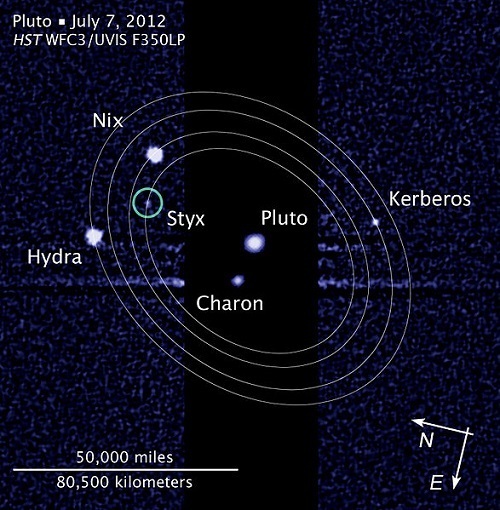
Image: A Hubble image of Pluto and its moons that has been modified by replacing “P4″ and “P5″ with the newer designations “Kerberos” and “Styx” respectively. Credit: NASA/Wikimedia Commons.
The SwRI study, described in this news release, modeled Charon itself by assuming a large impact in the early system, with additional moons built out of debris from this and other presumed collisions. Charon is fully one-tenth the mass of Pluto (by comparison, the Moon is 1/81 the mass of Earth), and its effect on early moon formation would be profound. Small moons that approached it would be flung outward while other small moons would collide, a series of early catastrophes that would lead to moon-building materials being pushed outward.
“The implications for this result are that the current small satellites are the last generation of many previous generations of satellites,” said Dr. Kevin Walsh, another investigator and a research scientist in SwRI’s Planetary Science Directorate at Boulder, Colo. “They were probably first formed around 4 billion years ago, and after an eventful million years of breaking and rebuilding, have survived in their current configuration ever since.”
All of which leads me to the New Horizons Message Initiative that was first announced at the 100 Year Starship Symposium in Houston not long ago. If you haven’t signed the NHMI petition yet, please visit the site and do so. The plan is to reconfigure a small portion of New Horizons’ computer memory, once its mission has been accomplished at Pluto/Charon and any Kuiper Belt objects beyond, so we can upload a message from humanity that will be crowd-sourced from all over the world. This is a private initiative and we need petition signatures to persuade NASA to consider this follow-up to the original Voyager ‘golden records.’ The NHMI is being developed through the capable work of Jon Lomberg and a team of volunteers. Lomberg’s work with Frank Drake in designing the cover for the Voyager records helped us gain perspective on our place in the cosmos as we reflected on what sights and sounds best represent our species.





October 15, 2013
Notes & Queries 10/15/13
Starship Century in London
A new Starship Century Symposium will be held at the Royal Astronomical Society, Piccadilly, UK on Monday October 21st. If I hadn’t exhausted my travel budget by September, I would definitely have this one on my agenda and follow it with a week or so in my favorite city. Here’s the information I have on the event from its organizers, James and Gregory Benford:
Starship Century addresses the challenges and opportunities for our long-�term future in space, with possibilities envisioned by featured speaker Lord Martin Rees, Royal Astronomer, Ian Crawford, Birkbeck College, University of London, writer/scientist Stephen Baxter, James Benford, Microwave Sciences, and Gregory Benford, UC Irvine. Starship Century discusses the implications that these explorations might have upon our development as individuals and as a civilization.
Agenda
10 am Starship Century: Toward the Grandest Horizon James & Gregory Benford
10:30 Scientific Benefits of Starships Ian Crawford
11:30 Contact at Alpha Centauri Stephen Baxter
1 pm -Break for lunch-
2 pm To the Ends of the Universe Lord Martin Rees
3:30 Exploring Interstellar Space Panel with Lord Martin Rees, Ian Crawford, Stephen Baxter, Jim & Greg Benford, others TBA
5 pm Symposium ends.
Proceeds from the sale of the Starship Century book go toward interstellar studies. Admission to the event is free.
Project Icarus Workshop
Yet another reason to get to the UK is the latest from Project Icarus, the continuing effort by Icarus Interstellar to produce a fusion starship design growing out of the original Project Daedalus work in the 1970s. Here’s what I have on this one from the Icarus team:
Project Icarus is presenting the results of our preliminary fusion-rocket based interstellar spacecraft at the British Interplanetary Society in London on October 21 and 22nd, 2013.
We are asking for support in raising $2000 to support our volunteer researchers and students attending the workshop. All donations made to Icarus Interstellar through October will be channeled to support the “2013 Project Icarus Design Competition”. FOUR (4) breakway teams are presenting variations of spacecraft designs and mission configurations which will be presented during an internal workshop on the 21st, followed by a public symposium on the 22nd of October.
In appreciation of your support, donors will receive:
$10 Your name listed in the acknowledgements of the final publication.
$20 Icarus Interstellar Lapel Badge (and above)
$50 Icarus Mug and t-Shirt (and above)
$100 Advance copies of the INTERNAL Spacecraft Design studies (and above)
$101 SPECIAL donations over $100 will receive an exclusive media pack containing HIGH RESOLUTION SPACECRAFT ENGINEERING DESIGNS rendered expertly by Adrian Mann (www.bisbos.com) (including all of the above!)
The exclusive content found in the INTERNAL Project Icarus Design Studies is the result of thousands of hours of research by our international volunteers. This is the FIRST TIME Icarus has shared full spacecraft designs. You can be among the exclusive few to explore our work first hand!
Icarus Interstellar the World’s Largest 501c(3) Deep Space and Interstellar Exploration Research Organization. All donations are tax exempt and deeply appreciated.
We are volunteers doing this work because it needs to be done.
Lets Build a Starship together!

White Dwarf Planets
My interest in planets around small stars is probably evident from the amount of space I spend on M-dwarfs and their planetary systems. Only recently have white dwarfs come into the picture for me, but as we’ve seen, Mukremin Kilic (University of Oklahoma) and colleagues have been discussing how to re-purpose the wounded Kepler observatory to look for transiting planets around such stars. About a year ago we also looked at Luca Fossati (The Open University, UK) and his work on the possibility of habitable white dwarf planets in exceedingly fortuitous orbits.
Now I have an email from science fiction writer Randy Blackwell, who has been working on a novel which raises interesting questions about habitable planets around white dwarf stars. Blackwell was looking for more details about possible conditions on the surface of such a world and I didn’t have the answers, so I thought it best to float his questions past the Centauri Dreams readership, many of whom have solved previous astronomical questions raised here.
Here’s Blackwell’s message about the scenario depicted in his novel:
The main characters find themselves on another planet. It is a water surface planet. The planet orbits a white dwarf. My complication is figuring out what the sky would look like by day and by night from the planet’s surface. Would there be an aura due to the great magnetism of the white dwarf? Would a dust trail be visible? If the desirable distance and size is 1 million miles at same size as Earth (both planet and dwarf) then what size would it look like in comparison to our Sun in the sky of the planet. Would it look closer or further? Would it be darker or more light with a 10 hour rotation?
I’m curious to see any answers to the questions Blackwell raises.
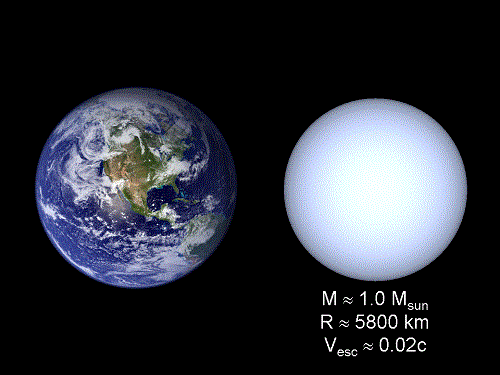
Image: A white dwarf as compared with the Earth. Credit: Ohio State University/Richard Pogge.
Deep Time in Aeon Magazine
A quick nod to Colin Dickey and his fine essay in Aeon Magazine on the Svalbard Global Seed Vault, which I actually encountered first in a post on the Long Now Foundation’s site. Looking at the lessons of geology and deep time, Dickey refuses to play the catastrophe card as a driver for long-haul projects like these. Calling the lessons of Svalbard “more complex than the simple, immediate apocalypse intimated by the hype surrounding the seed vault,” he goes on to say:
This recognition of the work of seed banks like the one in Svalbard is quotidian, bordering on the banal, and it can help to refocus an attitude towards the environment that sometimes verges on the self-important. A proper relationship to nature must involve a sense of stewardship, to be sure, and a willingness to work for a better tomorrow. But it might also do well to be stripped of a histrionic sense of perpetual catastrophe. Places such as Svalbard can help us to think on a much longer, deeper scale — one in which we are peripheral characters in a drama taking aeons to unfold.
In other words, a proper relationship between ourselves and the natural world is thoughtfully long-term whether or not global catastrophe ever forces us to rely on such repositories.






Paul Gilster's Blog
- Paul Gilster's profile
- 7 followers


